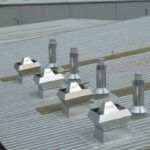Commercial roofing insulation is a critical component in any roofing system. It not only improves the building’s energy efficiency by reducing heat loss or gain but also enhances occupant comfort, protects the roof deck, and can extend the roof’s lifespan. Choosing the right type of insulation depends on the building’s climate, roofing system, budget, and performance requirements.
Here’s an overview of the most common types of commercial roofing insulation used today:
1. Polyisocyanurate (Polyiso) Insulation
Polyiso insulation is the most widely used rigid foam board insulation in commercial roofing. It offers a high R-value per inch—typically around R-6 to R-6.5—which means excellent thermal resistance in a relatively thin profile. Polyiso boards consist of a closed-cell foam core sandwiched between two facers, often coated fiberglass or foil.
Advantages:
-
High thermal performance
-
Lightweight and easy to install
-
Good fire resistance
-
Compatible with most roofing membranes (TPO, PVC, EPDM)
Disadvantages:
-
Performance can degrade in very cold temperatures
-
More expensive than some alternatives
Polyiso is ideal for new construction and reroofing projects, especially in moderate climates.
2. Expanded Polystyrene (EPS) Insulation
EPS is a rigid foam board made from expanded polystyrene beads fused together. It has an R-value of approximately R-3.6 to R-4.2 per inch, which is lower than polyiso but still effective.
Advantages:
-
Cost-effective and widely available
-
Moisture resistant, especially when coated or laminated
-
Lightweight and easy to handle
Disadvantages:
-
Lower R-value than polyiso or XPS
-
Less fire resistant; requires a thermal barrier in some cases
EPS is often used in roof systems where budget constraints exist, and higher thickness can compensate for lower R-value.
3. Extruded Polystyrene (XPS) Insulation
XPS is similar to EPS but manufactured using a different process, resulting in a closed-cell, denser foam board. It has an R-value around R-5 per inch.
Advantages:
-
Higher compressive strength, suitable for roofs with foot traffic or equipment loads
-
Good moisture resistance
-
Durable and long-lasting
Disadvantages:
-
Higher cost than EPS
-
Environmental concerns due to blowing agents used in manufacturing
XPS is commonly used in commercial roofing systems requiring durability and moisture protection, such as protected membrane roofs (PMRs).
4. Spray Polyurethane Foam (SPF) Insulation
SPF insulation is applied as a liquid that expands into a rigid foam, creating a seamless, monolithic layer on the roof deck. It provides excellent insulation with R-values from R-6 to R-7 per inch.
Advantages:
-
Seamless and self-adhering, reducing air leaks and thermal bridging
-
Excellent air and moisture barrier
-
Can conform to irregular shapes and fill gaps
Disadvantages:
-
Requires professional application with specialized equipment
-
Can be costly upfront
-
Must be protected with a coating to shield from UV damage
SPF is ideal for retrofit applications where complex roof geometry or air sealing is a priority.
5. Mineral Wool (Rock Wool) Insulation
Mineral wool insulation is made from natural or synthetic rock fibers, offering excellent fire resistance and sound attenuation.
Advantages:
-
Non-combustible and fire resistant
-
Water-resistant and dimensionally stable
-
Good acoustic properties
Disadvantages:
-
Lower R-value per inch compared to foam boards (around R-3.7 per inch)
-
Heavier than foam insulation, requiring strong roof deck support
Mineral wool is often chosen where fire code compliance is critical or enhanced soundproofing is needed.
6. Fiberglass Insulation
Fiberglass board insulation consists of compressed glass fibers bound into rigid panels. It has an R-value roughly between R-2.5 to R-4 per inch.
Advantages:
-
Economical option
-
Good fire resistance
-
Resistant to mold and mildew
Disadvantages:
-
Lower compressive strength compared to foam boards
-
Can absorb moisture if not properly protected
Fiberglass boards are sometimes used in built-up roofing (BUR) or modified bitumen systems.
Choosing the Right Commercial Roofing Insulation
When selecting insulation for a commercial roof, consider:
-
Thermal performance requirements: Check local building codes and energy standards.
-
Roof system compatibility: Ensure the insulation works well with your roofing membrane.
-
Moisture resistance: Particularly important in humid or wet climates.
-
Load-bearing capacity: For roofs with equipment or pedestrian traffic.
-
Fire safety ratings: Verify compliance with fire codes.
-
Installation method and budget: Some materials require specialized installation or higher upfront costs.
Conclusion
Choosing the right commercial roofing insulation is vital for optimizing energy efficiency, protecting the roof assembly, and ensuring long-term performance. Polyiso remains the industry favorite for many due to its high R-value and versatility, but EPS, XPS, SPF, mineral wool, and fiberglass all have important roles depending on project-specific needs.
Consulting with roofing professionals and insulation manufacturers will help you select the best insulation type for your commercial roofing project, ensuring a durable, cost-effective, and code-compliant solution.



